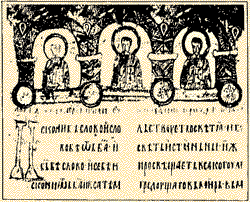Serbian language
|
|
| Serbian (српски) | |
|---|---|
| Spoken in: | Serbia and Montenegro, Bosnia and Herzegovina, Croatia, and other countries |
| Region: | Balkans |
| Total speakers: | 10 million (25M) |
| Ranking: | around 75 (44) |
| Genetic classification: | Indo-European Slavic South Western Serbian |
| Official status | |
| Official language of: | Serbia and Montenegro, Bosnia and Herzegovina |
| Regulated by: | Council for Standardization of the Serbian Language |
| Language codes | |
| ISO 639-1 | sr |
| ISO 639-2 | scc (B), srp (T) |
| SIL | srp |
| See also: Language – List of languages | |
The Serbian language is one of the standard versions of the Central-South Slavic diasystem, formerly (and still frequently) called Serbo-Croatian. Serbian is used primarily in Serbia and Montenegro, Republika Srpska and by Serbs everywhere.
It is based on the Štokavian dialect, has Western and Eastern spoken variants, and uses both the Cyrillic and Latin alphabets. Differences from other versions include phonetic transcription of foreign names.
Serbian literature emerged in the Middle Ages, and included such works as Miroslavljevo jevandjelje (The Gospel of Miroslav) in 1192 and Dušanov zakonik (Dušan's Code) in 1349. Little secular medieval literature has been preserved, but what there is shows that it was in accord with its time; for example, Serbian Alexandride, a book about Alexander the Great, and a translation of Tristan and Isolde into Serbian.
In the mid 15th century, Serbia was conquered by the Ottoman Empire, and for the next 400 years there was no opportunity for the creation of secular written literature. However, some of the greatest literary works in Serbian come from this time, in the form of oral literature, the most notable form being Serbian epic poetry. It is known that Goethe learned the Serbian language in order to read Serbian epic poetry in the original. Written literature was produced only for religious use in churches and monasteries, and held to Old Church Slavonic. By the end of the 18th century, the written literature had become estranged from the spoken language. In the early 19th century, Vuk Stefanović Karadžić, following the work of Sava Mrkalj, reformed the Cyrillic alphabet by introducing the phonetic principle, as well as promoting the spoken language of the people as a literary norm.
The first printed book in Serbian, "Oktoih" was produced in Cetinje in 1494, only 40 years after Gutenberg's invention of movable type.
Two Serbian words that are used in many of the world's languages are vampire and slivovitz.
Figures of speakers according to countries:
- Serbia-Montenegro: 7,170,000
- Serbia: 6,770,000
- Vojvodina: 1,557,020 (2002)
- Central Serbia: 5,063,679 (2002)
- Kosovo-Metohia: 150,000
- Montenegro: 401,382 (2003)
- Serbia: 6,770,000
- Bosnia-Herzegovina: 1,500,000
- Croatia: 44,629 (2001)
- Republic of Macedonia: 33,315 (2001)
- Romania: 20,377 (2001)
- Australia: 50,000 (2001)

See also
- Common phrases in Serbian
- Serbian proverbs
- Serbian tongue-twisters
- Famous non-Serbs who were speaking or learning the language
- Šatrovački (slang form)
- Romano-Serbian language (mix with Romany)
External links
Template:Interwiki Template:Wikibookspar
- Standard language as an instrument of culture and the product of national history (http://www.rastko.org.yu/isk/pivic-standard_language.html) An article by pre-eminent linguist Pavle Ivić
- Serbian School (http://www.serbianschool.com) Learn Serbian online for freebg:Сръбски език
cs:Srbština da:Serbisk de:Serbische Sprache es:Idioma Serbio fr:Serbe hr:Srpski jezik id:Bahasa Serbia ja:セルビア語 nl:Servisch no:Serbisk språk pl:Język serbsko-chorwacki sl:srbščina sr:Српски језик fi:Serbian kieli sv:Serbiska tl:Wikang Serbyo

